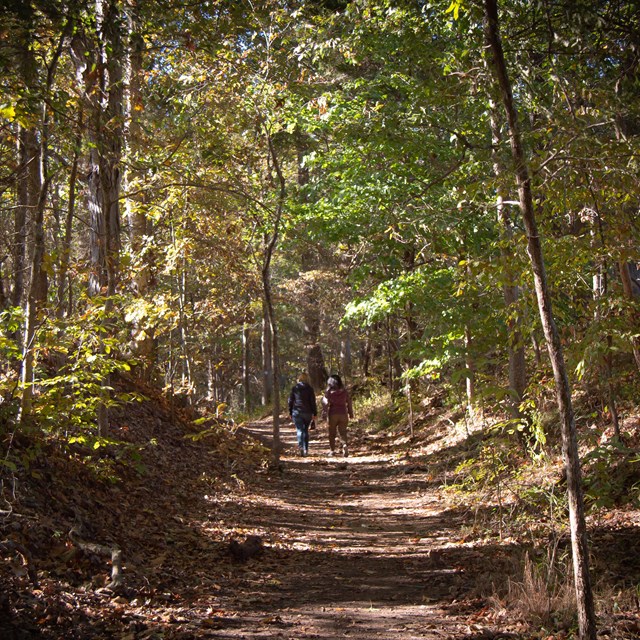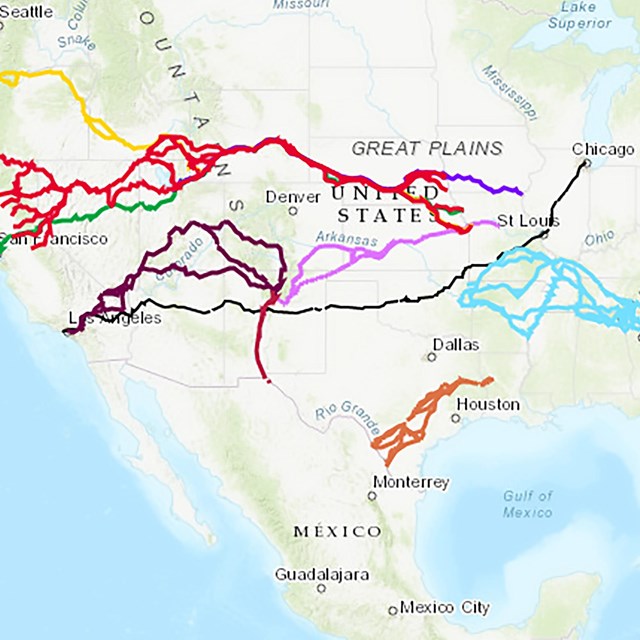Part of a series of articles titled Transportation During the Cherokee Removal 1837 - 1839.
Article
Wagons, Carriages, and Carryalls: Transportation During the Cherokee Removal 1837 - 1839
"We have a large number of sick, and very many extremely aged, and infirm persons in our detachment, that must of necessity be conveyed in the waggons [sic].”
– Jesse Bushyhead to John Ross, October 21, 1838
While the majority of Cherokee walked on the Trail of Tears due to an insufficient number of horses, oxen, and wagons, animal-powered wooden vehicles were still a constant presence on the trail and played an important role in the removal by carrying goods, the elderly, and the sick. Although vehicles helped in these roles, they required regular maintenance. Poor roads and difficult terrain, worsened by inclement weather, took a toll on the vehicles, which were prone to broken spokes and lost linchpins (a fastener to prevent the wheel from sliding off the axel).
Current research suggests that most of the wooden, animal-powered vehicles used on the Trail of Tears were either older vehicles acquired from sources in Pennsylvania, Virginia, and North Carolina, or they came from the hands of local companies, crafters, and blacksmiths. Some Cherokee families with means traveled the Trail of Tears in carriages or carryalls of their own. A man from Maury County, Tennessee, for example, observed the Benge detachment travel in front of his family’s home and noted, “Some of the Indian half-breeds were quite wealthy, owned slaves and rode in fine carriages.”
The largest local company in the Cherokee region was probably that of John Philip Nissen of Salem, North Carolina. The Moravian settlement at Salem had deep ties both culturally and economically with the Cherokees, and trading relationships dated to the 1790s. Interestingly, Nissen established his Salem wagon-making factory in 1834, sometime after the Cherokee Agency’s January 1834 announcement about the need for wagons to carry out removal. Within a decade, the Nissen wagon dominated the region.
“Tuesday about noon, the linch pin came out of one end of the fore axletree, the wheel came off and the end of the axletree, falling on the frozen ground broke, so that we had much trouble to get on to a waggon [sic] maker 6 miles forward.”
– Rev. Daniel S. Butrick, December 24-25, 1838

Photo/Courtesy of Library of Congress
Other North Carolina wheelwrights and crafters were located in Charlotte, Lincolnton, and Salisbury, and Catawba County near the boundary of Cherokee country. Eastin Morris’s Tennessee Gazetteer indicates several wagon-makers were active near the Cherokee settlements in Tennessee in the 1830s. At least some of the wagons used on the Trail of Tears came from Winchester, Franklin County, Tennessee. Cherokee leader John Ridge gave missionary William Chamberlain $3,000 to travel to Winchester to purchase wagons for his family.
Though many wooden vehicles shared many characteristics, they varied in shape and intended purpose. The Pennsylvania-based Swiss and German wagon-makers who developed the Conestoga wagon designed it to carry freight more so than people, though it did both. Large wheels, a curved bed, and a series of bows over which a canvas could be stretched for shelter were defining characteristics of this type of wagon. The curved bed helped center the freight and passenger weight, making the wagon more stable and creating more storage capacity.

Photo/Courtesy of Lewisville Historical Society
The Nissen Wagon Works produced a variation of the Conestoga wagon known as a “crooked bed” wagon. It was smaller, lighter in weight, and used more for farmwork rather than long-distance freighting. Despite the intended farm use, and given the company’s establishment just a few years before the federal government removed the Cherokee west, this type of farm wagon was likely present on the Trail of Tears.

Photo/Courtesy of The Henry Ford Museum
While the term carryall is seldom heard today, it was commonly used in the first half of the 19th century to describe a type of light, family wagon used in the central Atlantic states, and later used to describe light Rockaways. “Carryall” was used interchangeably with other names to identify slightly different types of wooden vehicles at the time, but generally referred to a light, covered four wheeled carriage with two seats inside, drawn by a single horse. More often used to carry people than heavy loads, some carryalls had convertible tops, stuffed seat cushions, and exterior paint.
The Rev. Daniel S. Butrick, who traveled with the Richard Taylor detachment on the Trail of Tears, repeatedly referred to his vehicle as a carryall, as opposed to a wagon or carriage, which were terms he regularly used to identify other vehicles. On November 14, 1838, Butrick acquired a “new oil cloth” in Woodbury, Tennessee, to put on the top of his carryall as a result of the rainy weather. Butrick and his wife often slept in their carryall on the Trail of Tears but stored their bedding and tent in a larger wagon during the day.
The stagecoach is an evolved form of an 18th century stage wagon. The stagecoach had an oval body suspended by thorough braces. The driver’s seat was located outside of the passenger body, which had at least one door on the side. This form evolved into what is known as the American Mail Coach or the Concord Coach, which ranged in size to hold from six to nine passengers.
Less expensive passenger coaches with square-shaped passenger boxes and open sides were also built. These were referred to as Passenger Wagons, Overland Wagons, Mud Wagons, and Mountain Wagons. It is possible that these could have been used on the Trail of Tears. Another popular form was the coachee, a light family carriage with curtains that placed the driver and the passenger under the same roof.
“Soon after dark it commenced raining, and the wind drove the water into our carryall so that our bed and cloths became quite wet on one side. The weather also became very cold, and our blankets over the waggon [sic] were covered with snow when we rose.”
– Rev. Daniel S. Butrick, December, 24-25, 1838
The invention of the steamboat and railroads, along with vast improvements in the construction, design, and maintenance of roads and turnpikes, marked the beginning of a transportation revolution in the United States during the early 1800s. The Cherokee removal occurred as this revolution began to unfold. While the Cherokee utilized these transformative modes of transportation during their forced removal, it is important to remember that the majority traveled by foot on roads over rough terrain.
This publication was made possible by the Cooperative Ecosystem Studies Unit (CESU) Task Agreement P18AC01316 with National Trails– National Park Service and the Center for Historic Preservation at Middle Tennessee State University.
Read the Full Report
Last updated: December 21, 2021


